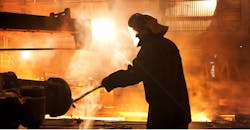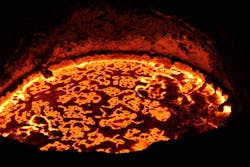Eliminate Inductor Loop Plugging and EF Build-Up
Experience does not equal expertise. In some foundries, experience has consolidated into bad habits and/or misunderstanding. For example, recently an electric furnace expert asserted that "the only reasonable method of cleaning the inductor channel is to rod it mechanically." Others recommend special fluxes to remove slag build-ups in electric furnaces. It is much simpler and safer to prevent slag formation.
Iron deoxidation technology has demonstrated that induction-furnace slag and inductor-loop plugging result from molten iron oxidation. It is a case in which technology-supported steps rule out seat-of-the-pants methods. Slag is the issue, so why not approach the problem by eliminating the slag rather than dealing with its presence?
Molten iron oxidation produces iron oxide that, once formed, breaks down and continually supplies free oxygen atoms to the molten iron bath. These short-lived, highly charged oxygen atoms disperse throughout the bath, causing oxidation throughout the furnace.
One of the dispersed oxides formed in the molten bath is iron oxide, which acts as the "glue" combining other oxides present into a mass. The glue holds together other oxide molecules to form "spinel oxide clusters" – and it’s these spinel clusters that cause plugging of the inductor loop, as well as inlets and outlets, and the furnace sidewall build-up that have plagued foundry melting personnel forever.
All conventionally melted iron contain these unwanted oxygen atoms. Once the oxygen atoms are present in the bath, the stage is set for spinel-oxide cluster formation. If oxygen is present, the spinel clusters will always form.
Specifically, iron oxide-based spinels are the root cause of the furnace problems. It is important to declare the specific identity of the slag build-ups as the basis because Mastermelt's deoxidation technology revolves around the chemical reduction of iron oxide. Iron oxide is revealed as the "root of all evil." Once the EF is cleared of iron oxide, the molten iron self-cleans of free-oxygen atoms and oxide molecules.
The self-cleaning mechanism includes nano-sized oxide molecules suspended within the bath, agglomerating and floating out of the bath. Because iron oxide is not physically present in the resulting slag mass, the slag mass becomes a "dry-like" slag, an asset to clean iron production because it forms a barrier to further molten iron atmospheric contact.
And because free oxygen atoms are not resupplied, the bath quickly becomes depleted of free oxygen – that is "deoxidized."
All of the mechanical methods for removing slag cause harm and reduce furnace service life.
In addition to the mechanical methods for removing slag build-up and loop plugging, foundries commonly resort to high temperature "run-ups" of the molten iron bath to melt away the spinels that continually form. This later method creates the most harm, significantly shortening the furnace and inductor service life.
The suggestion that mechanical rodding should be used to clean the inductor channel is far better than the commonly used, high-temperature run-ups of the entire furnace bath. But mechanical rodding of the inductor loop is a "man-killer" and should be avoided at all costs.
Rather than resort to the dangerous and physically demanding mechanical rodding of the inductor loops, and the mechanical chipping of slag build-up on the furnace sidewalls, inlets and outlets, a novel approach based on Mastermelt's new iron deoxidation technology has proven to be fully effective.
Problems dissolve
The new Mastermelt technology stops furnace loop plugging. In fact, existing inductor loop plugging created by old conventional melting methods dissolve away when iron deoxidation commences and removes the free oxygen atoms in the molten iron.
Iron deoxidation is accomplished with specialty blends of silicon carbide and pet-coke. The particular SiC accomplishes the deoxidation and the equally special pet-coke prevents the re-oxidation of the deoxidized molten iron. While this technology has been proven in production it remains largely unknown by iron melting operations. However, it has gained acceptance by the rising number of technologists to have tested it.
The blended deoxidizing material is known as DeOX D-1. Physically, it is a granular material that is added to the EF during the melt cycle or added to the holding/pouring furnace with fresh iron. For auto-pour type furnaces, DeOX D-1 is added into the existing slag present in the furnace. The resulting slag is converted to an iron oxide-free slag which consequently changes to a dry-type cover slag. Then, the converted slag can be maintained on the iron bath as it acts to prevent radiated heat losses to the furnace roof. It is best that the neutralized slag cover be maintained and not removed.
Contrary to common belief, a slag-free bath is not desirable. Slag cover reduces heat loss to the furnace roof, reducing holding power in the furnace.
Converting an auto-pour type furnace requires little DeOX D-1. Once the existing iron oxide is neutralized, only small, ongoing additions of DeOX D-1 are periodically required.
Fully converted ductile iron, maintained in an auto-pour furnace, encounters reduced nodularity fade due to no iron oxide contacting the converted DI. DeOX D-1 has neutralized the iron oxide, changing it to inert by-products, iron oxide's supply of free-oxygen atoms being the primary cause of nodularity fade. Magnesium loss is nearly stopped when iron oxide is controlled. Testing is currently underway to determine the magnesium loss rate for fully converted ductile iron in an iron oxide-free pouring furnace and the precise levels of magnesium needed to maintain full nodularity.
Ron Beyerstedt is the president of Mastermelt LLC.

